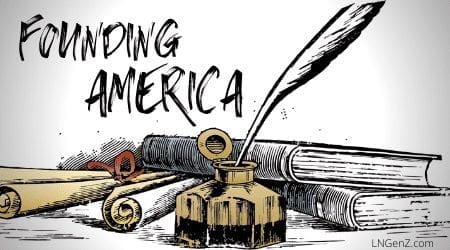-
Declaring Independence
- The Spark of Revolution – Lesson – VIDEO
- Declaration of Independence: Freeing America from Foreign Rule – Lesson
- Declaration of Independence: Freeing America from Foreign Rule – Quiz
- Declaration of Independence “Rough Draught” Now on Microfilm – Lesson
- Declaration of Independence “Rough Draught” Now on Microfilm – Quiz
- Independence Day: The History You Might Not Know – Lesson
- Independence Day: The History You Might Not Know – Quiz
-
Fighting for Independence
- The American Revolution: From British Subjects to US Citizens – Lesson
- The American Revolution: From British Subjects to US Citizens – Quiz
- The Black Patriots and Freedom in America – Lesson
- The Black Patriots and Freedom in America – Quiz
- Revolutionary Women: America’s Founding Females – Lesson
- Revolutionary Women: America’s Founding Females – Quiz
-
Founding a New Republic
Declaration of Independence “Rough Draught” Now on Microfilm – Lesson
Jefferson’s first draft was wordier, but it gives a deeper understanding of his beliefs.
When the leaders of the British colonies in America decided it was time to split off from England, they knew the letter had to be just right. A committee was appointed by the Continental Congress and the Declaration of Independence was born. But the final version we’re used to is not the original draft written by Thomas Jefferson. That version is now available in high-resolution microfilm, scans of which can be seen from anywhere in the world online.
 The committee to draft the Declaration of Independence included Thomas Jefferson, John Adams, Benjamin Franklin, Roger Sherman, and Robert Livingston. Jefferson took the lead on the draft, and it is believed that his work on the Virginia Constitution greatly influenced the Declaration. According to the Library of Congress, 86 changes were made by the others in the committee and the rest of Congress. Jefferson did not appreciate some of the changes, but the most offensive to him was the removal of a paragraph blaming King George III for slavery. It read:
The committee to draft the Declaration of Independence included Thomas Jefferson, John Adams, Benjamin Franklin, Roger Sherman, and Robert Livingston. Jefferson took the lead on the draft, and it is believed that his work on the Virginia Constitution greatly influenced the Declaration. According to the Library of Congress, 86 changes were made by the others in the committee and the rest of Congress. Jefferson did not appreciate some of the changes, but the most offensive to him was the removal of a paragraph blaming King George III for slavery. It read:
“he has waged cruel war against human nature itself, violating it’s most sacred rights of life & liberty in the persons of a distant people who never offended him, captivating & carrying them into slavery in another hemisphere, or to incur miserable death in their transportation thither. this piratical warfare, the opprobrium of infidel powers, is the warfare of the CHRISTIAN king of Great Britain. determined to keep open a market where MEN should be bought & sold, he has prostituted his negative for suppressing every legislative attempt to prohibit or to restrain this execrable commerce: and that this assemblage of horrors might want no fact of distinguished die, he is now exciting those very people to rise in arms among us, and to purchase that liberty of which he has deprived them, & murdering the people upon whom he also obtruded them; thus paying off former crimes committed against the liberties of one people, with crimes which he urges them to commit against the lives of another.”
Some of the other changes included:
- “We hold these truths to be sacred & undeniable” became “We hold these truths to be self-evident.”
- “that from equal creation they derive in rights inherent & inalienable, among which are the preservation of life, & liberty, & the pursuit of happiness” was shortened to “that they are endowed by their Creator with certain unalienable rights, that among these are life, liberty, and the pursuit of happiness.
- “He has called together legislative bodies at places unusual, uncomfortable, and distant from the depository of their public records, for the sole purpose of fatiguing them into compliance with his measures,” was added to the draft.